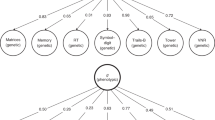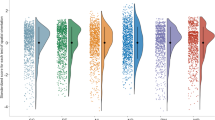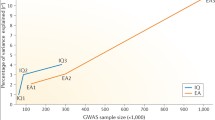Abstract
We examined the genetic architecture of a Tower of London test of planning and problem-solving in 690 middle-aged male twins. Phenotypic analyses revealed only one general factor, but the best-fitting genetic model indicated two correlated genetic factors: speed and efficiency. One variable—number of attempts required to mentally figure the puzzles—loaded on both factors. Shared environmental effects could be dropped with virtually no reduction in model fit. Despite significant nonshared environmental correlations across measures, there was no discernable nonshared environmental factor structure. The correlation between genetic factors (r = 0.46) and the variable loading on both factors could reflect modulation of planning, testing alternatives, and working memory that are required to perform the test. Such coordinated activity is consistent with the notion of a supervisory attentional system, a central executive, or metacognitive ability. The different phenotypic and genetic factor results suggest that relying solely on the former could obscure genetic associations.


Similar content being viewed by others
Notes
We use Tower of London as a general term referring to the original Shallice task as well as other variants that have been developed.
Test 1 actually had 18 trials but 4 trials were scored incorrectly due to a computer program error. Thus, scores were based on the average of the 14 useable trials.
To provide additional confirmation of our conclusions, we also reversed the order of these approaches. That is, we tested whether the nonshared environmental covariance structure could be simplified while not imposing any constraints on the genetic factor structure (i.e., leaving the genetic factors as a Cholesky). Because these results yielded identical conclusions about the nature of the nonshared environmental covariance structure, we present only the first set of results.
References
Akaike H (1987) Factor analysis and AIC. Psychometrika 52:317–332
Andreasen NC, Rezai K, Alliger R, Swayze VW II, Flaum M, Kirchner P, Cohen G, O’Leary DS (1992) Hypofrontality in neuroleptic-naive patients and in patients with chronic schizophrenia. Assessment with xenon 133 single-photon emission computed tomography and the Tower of London. Arch Gen Psychiatr 49:943–958
Baddeley AD (1986) Working memory. Oxford University Press, Oxford
Berg WK, Byrd DL (2002) The Tower of London spatial problem-solving task: enhancing clinical and research implementation. J Clin Exp Neuropsychol 24:586–604
Bouchard TJ Jr, McGue M (2003) Genetic and environmental influences on human psychological differences. J Neurobiol 5:44–45
Davis HP, Bajszar G, Squire LR (1994) Colorado neuropsychology tests, version 2.0. Colorado Springs, CO
Eaves LJ, Last KA, Young PA, Martin NG (1978) Model-fitting approaches to the analysis of human behavior. Heredity 41:249–320
Eisen SA, True WR, Goldberg J, Henderson W, Robinette CD (1987) The Vietnam Era Twin (VET) registry: method of construction. Acta Genet Med Gemellol 36:61–66
Eisen SA, Neuman R, Goldberg J, Rice J, True W (1989) Determining zygosity in the Vietnam Era Twin registry: an approach using questionnaires. Clin Genet 35:423–432
Fuster JM (1989) The prefrontal cortex: anatomy, physiology and neuropsychology of the frontal lobe. Raven Press, New York
Henderson WG, Eisen SE, Goldberg J, True WR, Barnes JE, Vitek M (1990) The Vietnam Era Twin registry: a resource for medical research. Public Health Rep 105:368–373
Koren D, Seidman LJ, Goldsmith M, Harvey PD (2006) Real-world cognitive-and metacognitive-dysfunction in schizophrenia: a new approach for measuring (and remediating) more “right stuff”. Schizophr Bull 32:310–326
Koriat A, Goldsmith M (1998) The role of metacognitive processes in the regulation of memory performance. In: Mazzoni G, Nelson TO (eds) Metacognition and cognitive neuropsychology: monitoring and control processes. Lawrence Erlbaum, Mahwah, pp 97–118
Kyllonen PC, Christal RE (1990) Reasoning ability is (little more than) working memory capacity? Intelligence 14:389–433
Levin HS, Fletcher JM, Kufers JA, Harward HJ, Lilly MA, Mendelsohn D, Bruce D, Eisenberg H (1996) Dimensions of cognition measured by the Tower of London and other cognitive tasks in head-injured children and adolescents. Develop Neuropsychol 12:17–34
Markon KE, Krueger RF (2004) An empirical comparison of information-theoretic selection criteria for multivariate behavior genetic models. Behav Genet 3:593–610
Neale MC, Cardon LR (1992) Methodology for genetic studies of twins and families. Kluwer, Dordrecht
Neale MC, Boker SM, Xie G, Maes HH (2003) Mx: statistical modeling. Department of psychiatry. Medical College of Virginia, Richmond
Nelson TO, Narens L (1990) Metamemory: a theoretical framework and new findings. In: Bower GH (ed) The psychology of learning and motivation. Academic Press, New York, pp 125–173
Nichols RC, Bilbro WCJ (1966) The diagnosis of twin zygosity. Acta Genet Stat Med 16:265–275
Owen AM, Downes JJ, Sahakian BJ, Polkey CE, Robbins TW (1990) Planning and spatial working memory following frontal lobe lesions in man. Neuropsychologia 28:1021–1034
Owen AM, James M, Leigh PN, Summers BA, Marsden CD, Quinn NP, Lange KW, Robbins TW (1992) Fronto-striatal cognitive deficits at different stages of Parkinson’s disease. Brain 115:1727–1751
Peeters H, Van Gestel S, Vlietinck R, Derom C, Derom R (1998) Validation of a telephone zygosity questionnaire in twins of known zygosity. Behav Genet 28:159–163
Phillips LH, Wynn VE, McPherson S, Gilhooly KJ (2001) Mental planning and the Tower of London task. Q J Exp Psychol A 54:579–597
Robbins TW, James M, Owen AM, Sahakian BJ, McInnes L, Rabbitt PMA (1998) A neural systems approach to cogntive psychology of ageing using the CANTAB battery. In: Rabbitt PMA (ed) Methodology of frontal and executive function. Psychology Press, Hove, pp 215–238
SAS Institute (2000) SAS/STAT user’s guide, volume 8. SAS Institute, Carey
Shallice T (1982) Specific impairments of planning. Philos Trans R Soc Lond B Biol Sci 298:199–209
Shimamura AP, Metcalfe J (1994) Metacognition: knowing about knowing. MIT Press, Cambridge
Stuss DT, Benson DF (1986) The frontal lobes. Raven Press, New York
Swan GE, Carmelli D (2002) Evidence for genetic mediation of executive control: a study of aging male twins. J Gerontol 578(2):133–143
Tsuang MT, Bar JL, Harley RM, Lyons MJ (2001) The Harvard Twin study of substance abuse: what we have learned. Harv Rev Psychiatr 9:267–279
Unterrainer JM, Rahm B, Kaller CP, Leonhart R, Quiske K, Hope-Selyer K, Meier C, Müller C, Halsband U (2004) Planning abilities and the Tower of London: is this task measuring a discrete cognitive function? J Clin Exp Neuropsychol 26:846–856
Ward G, Allport A (1997) Planning and problem-solving using the five-disc Tower of London task. Q J Exp Psychol 50:A49–A78
Welsh MC, Satterlee-Cartmell T, Stine M (1999) Towers of Hanoi and London: contribution of working memory and inhibition to performance. Brain Cogn 41:231–242
Williams LJ, Holahan PJ (1994) Parsimony-based fit indices for multiple-indicator models: do they work? Struct Equ Model 1:161–189
Zook NA, Davalos DB, Delosh EL, Davis HP (2004) Working memory, inhibition, and fluid intelligence as predictors of performance on Tower of Hanoi and London tasks. Brain Cogn 56:286–292
Acknowledgments
Preparation of this article was supported in part by National Institute of Alcohol Abuse and Alcoholism AA10586 and National Institute on Aging Grants AG18386-A1, AG18386-A2, AG22381, and AG22982. Portions of these data were presented at the Behavior Genetics Association meeting, July 2005, and the Gerontological Society of America meeting, November 2005. The US Department of Veterans Affairs has provided financial support for the development and maintenance of the Vietnam Era Twin (VET) Registry. Numerous organizations have provided invaluable assistance in the conduct of this study, including: Department of Defense; National Personnel Records Center, National Archives and Records Administration; Internal Revenue Service; National Opinion Research Center; National Research Council, National Academy of Sciences; the Institute for Survey Research, Temple University. Most importantly, the authors gratefully acknowledge the continued cooperation and participation of the members of the VET Registry and their families. Without their contribution this research would not have been possible.
Author information
Authors and Affiliations
Corresponding author
Additional information
Edited by Danielle Posthuma.
Rights and permissions
About this article
Cite this article
Kremen, W.S., Jacobson, K.C., Panizzon, M.S. et al. Factor Structure of Planning and Problem-solving: A Behavioral Genetic Analysis of the Tower of London Task in Middle-aged Twins. Behav Genet 39, 133–144 (2009). https://doi.org/10.1007/s10519-008-9242-z
Received:
Accepted:
Published:
Issue Date:
DOI: https://doi.org/10.1007/s10519-008-9242-z




